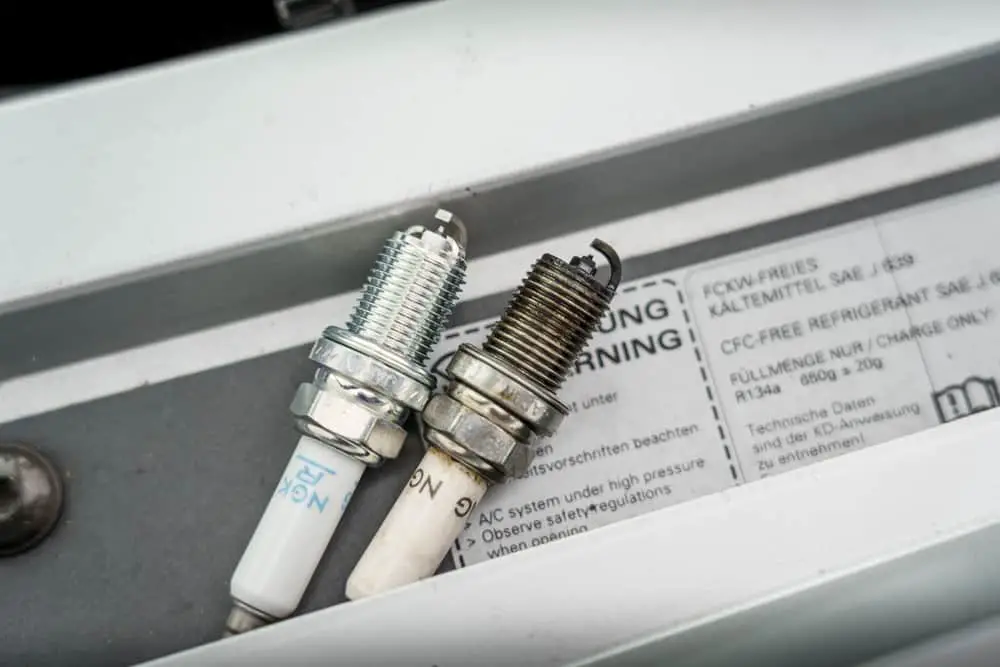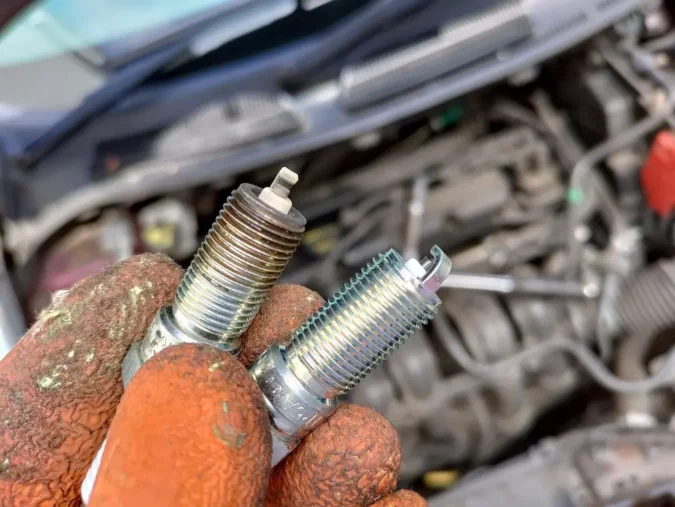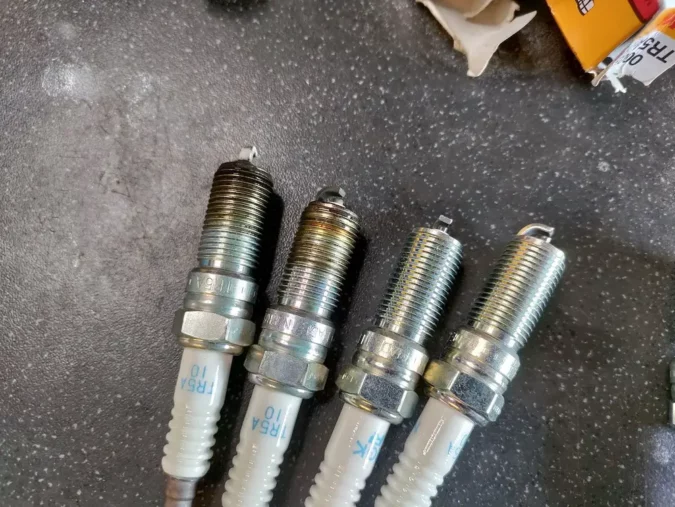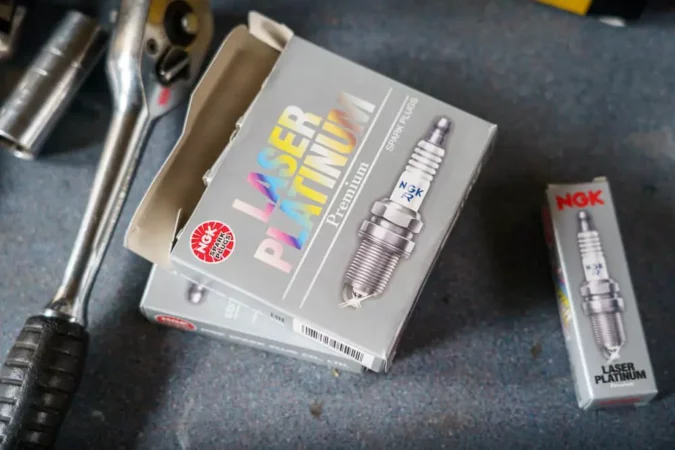How many spark plugs does a diesel have? Diesel engines do not employ an explosion of gasoline and air inside the cylinder, hence they do not use spark plugs. The carburetor draws fuel and air into the cylinder in four-stroke gasoline engines that use conventional fuel. This causes it to be compressed, and when the perfect time comes, a spark from the spark plugs jumps out, causing the mixture to erupt and start the engine.
In the case of diesel, just air is drawn in, and because of the high pressure it is subjected to in the combustion chamber, it becomes hotter. The diesel is then injected and starts to burn. Spark plugs are not needed either because there is no need for a spark (you can learn more in our guides on what do spark plugs do).
- Gas vs Diesel Engines
- How many Spark Plugs?
- Glow vs Spark Plugs
- How many Glow Plugs?
- Stages of Glow Plugs
- Types of Glow Plug
- How Frequently to Replace?
- How to Fix it?
- What will be the Cost?
Gas vs Diesel Engines
It starts with how each engine utilizes various fuels. All internal combustion engines operate largely in the same way. Fuel is introduced into the combustion chamber of an engine, the fuel is ignited or combusted, and the resulting explosion moves the piston. The crankshaft rotates due to the moving piston, sending power to the transmission and, ultimately, the driving wheels.
Power can be increased by adding more pistons. Additionally, car experts have been researching ways to increase engine power while consuming less fuel for the past 130 years. Due to the structural differences between gasoline and diesel fuel, each type of engine has a unique way of affecting how the fuel burns in the combustion chamber.
Fundamentally, while diesel is considered a combustible fluid, gasoline is a flammable liquid. This implies that a spark is all it needs to ignite the gas. On the other hand, the more dense diesel fuel has a higher boiling point (not to mention why is diesel so expensive) and needs a high-compression combustion chamber to function as a vehicle fuel source.
This implies that gasoline poses a risk in some circumstances where uncontained fuel is present, such as an automobile accident with a punctured fuel tank. An accidental spark or flame easily ignites gasoline; in fact, it’s the gas’s vapors that burn, not the liquid itself.
There is no spark from the spark plug in a diesel engine because they do not utilize them. This is one of the primary distinctions between diesel and gasoline engines. This is also the reason why accidentally finding out what happens if you put gas in a diesel engine is a very bad idea.
How Many Diesel Engine Spark Plugs Are There
There are none in the diesel engine. Glow plugs, not spark plugs, are used to power diesel engines. In typical setups, there is one glow plug for each cylinder. Consequently, an ordinary configuration of your 8-cylinder diesel engine would have eight glow plugs.
Engines powered by gas and diesel behave differently. Glow plugs are needed because the diesel engine requires a heating device. Spark plugs and glow plugs have similar designs. However, the glow plug serves a different purpose.
Glow Plug vs Spark Plug
Here’s a comparison between glow plugs and spark plugs…
1. Glow Plugs
The glow plug provides heating. Although it resembles a spark plug, it does not ignite the air or gasoline inside the pistons. In warmer areas, the diesel engine could function without glow plugs. However, each cylinder has an electrical heating component that ensures a steady start as the temperature drops.
2. Spark Plugs
Each and every gasoline-powered engine has a spark plug. For the most part, gas engines have one spark plug per cylinder. So, if your gas engine has six cylinders, you would probably locate six spark plugs; one for each cylinder. The vehicle engine fires these spark plugs in a specific order to produce the spark required to ignite the mixture (i.e. the air-to-fuel ratio) in the combustion chamber.
A minor explosion occurs inside the engine to ignite the mixture of fuel and air. When this explosion occurs, the engine piston is driven down, generating the force that propels your car forward. The diesel engine, however, doesn’t need ignition to run. The glow plugs deliver the pressure and heat that it actually requires.
For more insight on what are spark plugs and how they work, you can check out our guides on:
- NGK vs Denso – which brand of spark plug is best
- What does a bad spark plug look like
- Platinum vs Iridium spark plugs – which is better
- How to check spark plugs for problems
How Many Diesel Engines Have Glow Plugs
It shouldn’t be surprising that a gas engine has a comparable number of glow plugs to spark plugs. Most likely, each cylinder in your diesel engine has one glow plug. So, if your diesel engine has six cylinders, you should be able to find six glow plugs. Similar to this, an 8-cylinder diesel engine frequently has 8 glow plugs. Of course, this rule is subject to exceptions.
Stages At Which Glow Plugs Are Required
Here are some crucial processes and stages in the workings of glow plugs…
1. Pre-Ignition
The glow plugs are warming up the cylinders before ignition. The glow plugs operate as soon as the ignition is turned to the ON position. Sometimes waiting a few minutes after turning the ignition to ON before starting the engine helps diesel owners get better performance. It’s recommended to give yourself some extra time because the heating process can take a little longer with older cars.
2. Ignition
The glow plugs might also be useful as you start the engine. The spark that ignites the mixture of air and fuel, on the other hand, is not produced by glow plugs. Instead, the glow plugs help maintain the temperatures during this time for optimal combustion. When the temperature is just correct, combustion can happen more quickly and effectively.
3. Post Ignition
After the engine starts, the glow plugs keep the combustion chamber warm for some time. Heating things up helps combustion happen effectively. Additionally, when the combustion chamber heats up, less noise is produced. The glow plugs make sure that everything keeps working correctly.
Glow Plug Types
The best glow plugs for your car depend on a few different things. There are three types of plugs: hot, medium, and cold. When buying new plugs, consider the amount of nitro, the type of engine, the size, and the acceleration.
- A colder glow plug results from a high nitro percentage. Use a hotter glow plug when the percentage is low.
- Depending on the engine and manufacturer, certain glow plugs may be needed for turbo engines.
- Large engines can employ colder plugs while small engines typically require hot lights.
- For acceleration or to enhance sluggish performance, hot glow plugs are recommended.
- Cold plugs can generate more power and torque.
1- Pressure Sensor Glow Plugs (PSG)
These plugs have a built-in pressure sensor, which helps increase your engine’s efficiency. The sensor notifies the engine control unit of the pressure in the cylinder. PSG plugs can improve fuel efficiency and make it simpler to start your car in the cold. They work wonders in reducing your car’s emissions.
2- Ceramic Glow Plugs (CPG)
Glow plugs made of ceramic heat up quickly. In comparison to their competitors, they can also attain far higher temperatures. In the coldest weather, you’ll be able to start your car right away because it will heat up quickly. When ceramic plugs are used, diesel fuel burns efficiently. For the majority of automobiles, CPG plugs offer optimum efficiency.
3- Steel Glow Plugs
A steel plug is also dependable and effective. A steel glow plug will have no trouble starting your car in extremely cold temperatures; however, it might take longer.
How Frequently Should You Replace Glow Plugs Diesel Engine?
Glow plug replacement is necessary for any engine to operate at its peak efficiency. Fortunately, changing plugs is inexpensive and simple. The best time to examine your used glow plugs is during a routine tune-up at roughly 12,000 miles. For more references on how long this is, you can check out our explainer on how long do spark plugs last.
There could be various maintenance regimens for various automobiles. To determine when to undertake scheduled maintenance, refer to your vehicle’s owner’s manual. Most glow plugs last at least 100,000 miles on average. Every plug in your engine needs to be replaced when one is damaged. This will guarantee that each cylinder is operating at its peak efficiency.
Glow plug replacement is simple and inexpensive. Most inexperienced mechanics can replace new glow plugs in their garage or driveway. Of course, hiring a qualified mechanic to replace them is also inexpensive.
Fixing Glow Plug Issues
Are you experiencing auto issues? Your plugs can be to blame for issues like poor efficiency and starting problems. The following are some signs to watch out for that could indicate faulty glow plugs (you can then cross-reference them, for more context, with our write-up on the symptoms of a bad spark plug).
- In chilly weather, especially, your car won’t start.
- Poor glow plug performance reduces fuel economy.
- Damaged plugs may result in a car that misfires.
- Your engine’s smoke could indicate damaged glow plugs.
- Malfunctioning glow plugs may cause ineffective fuel economy.
- Plug faults are a common cause of diesel knocking noises.
- Glow plug issues can occur in vehicles struggling to accelerate or with insufficient power.
- Glowing warning lights on your car may indicate that your glow plugs need to be replaced.
Glow plug issues could cause any reduction in power, performance, or efficiency. The good news is that glow plug replacement is a simple and affordable fix.
Glow Plug Replacement Cost
A diesel engine’s glow plugs can cost between $200 and $300 to replace. Of that price, the parts might account for $75 to $125, while the labor would run between $125 and $175. For a bit of context, do check out our guides on the spark plug replacement cost. The engine will take longer to start as the glow plugs begin to deteriorate, especially in cold regions.
There are fewer problems as the glow plugs deteriorate if the engine has an external block heater. Additionally, performance concerns can be until the engine reaches normal operating temperature. Just remember that when installing glow plugs, you might have to grease them up, akin to how spark plugs require dielectric grease.
Driving is still possible with faulty glow plugs. There shouldn’t be any significant problems keeping your car in operation when the glow plugs fail because they are not required for the regular operation of the running engine. When you try to start the diesel engine in extremely cold weather, that’s when you’ll notice the biggest problem.
Starting A Diesel Engine Without Glow Plugs
Can a diesel engine start without glow plugs, then? The quick answer is yes, but it also heavily depends on the outside temperature; if it’s too cold outside, the car might not start at all without the glow plug system, or it might sputter briefly before the idle settles down.
Glow plugs are unnecessary when the temperature is at 70 degrees or higher, and most diesel engines will start up without any trouble immediately. The engine will probably need to crank more slowly to start without the glow plugs, which is why it can be dangerous. As a result, the starter and batteries are subjected to additional strain and wear.
What Happens When Plugging In A Diesel Truck
Once temps drop, diesel fuel may flow gell up. The engine’s oil will experience the same thing (unless you’re noticing issues such as seeing motor oil in your spark plug well, or if you’re seeing oil on the spark plug itself). It will cease to lubricate the moving elements of your engine once it becomes sticky in texture.
Especially if you have a newer vehicle, the engine will ultimately reach the temperature it requires to function effectively. But you don’t want to put the engine through that kind of stress. Over time, the damage could build up.
The heater might increase the engine’s temperature when the diesel truck is plugged in. You can start driving away after plugging in a diesel vehicle without waiting for it to warm up. If there is an emergency, you can start driving immediately, saving you time.
A heater may also help your engine last longer if it’s always cold where you live. The heater is not necessary. Despite the lack of engine block heaters in their older models, many car owners still use their vehicles in the winter. Speak with a reliable professional if you are unsure whether an engine block warmer is necessary.
They can let you know if your car needs a heater or not. They will also determine when it is OK to plug the truck in. Some automobiles are powerful. Only connect them when it’s extremely cold outside. If you don’t turn on the engine block heater, some people might not want to work in warmer weather.
Fuel Injector vs Spark Plug
Two essential parts of an internal combustion engine are the fuel injector and the spark plug. They collaborate to supply and ignite gasoline to power the engine. Fuel Injector: The fuel injector is a mechanical device that the engine’s combustion chamber uses to feed fuel from the fuel tank.
A thin fuel mist is sprayed into the combustion chamber or into the intake manifold, where it mixes with the incoming air. To ensure that the fuel is atomized and readily combustible, the fuel injector runs at high pressure, often between 30 and 100 bar.
The fuel injector is attached to the engine’s fuel system and is normally found in the intake manifold or cylinder head. It functions in reaction to signals sent by the engine control unit (ECU), which determines the necessary fuel amount depending on various inputs, including engine speed and load, and controls the injectors as necessary.
The spark needed to ignite the fuel/air mixture in the combustion chamber is provided by the spark plug, a part found in the cylinder head. It comprises a spark plug wire coupled to a metal electrode enclosed in an insulator. A spark is produced across the electrode gap when the spark plug receives a high-voltage signal from the ignition system.
The air/fuel combination is ignited by this spark, which causes it to erupt and move the piston. Spark plugs are made to work in situations that can reach temperatures of over 10,000°C and pressures of up to 30 bar. They typically consist of a metal core with a nickel or platinum center electrode and an insulator made of ceramic or another material around it.
Use Of Heater Plugs For Diesel Engines
Before starting a diesel engine, the engine block and fuel system are preheated using a heating plug. This is especially helpful during cold weather when diesel fuel can thicken and be challenging to ignite. In order to facilitate starting the engine and lessen wear on the starting system, the heater plug thins the fuel and increases its volatility.
Using a heater plug can help the diesel engine last longer and enhance cold weather starting. The heater plug helps speed up the process of getting the engine up to operating temperature by preheating the fuel system and engine.
This can lessen engine wear and guard against harm from excessive idling. By making the engine warm up and run more smoothly, the heater plug can also aid in lowering emissions. When the key is turned to the “start” position in some diesel engines, the heating plug activates automatically since it is integrated into the engine’s glow plug system.
FAQs On How Many Spark Plugs Does A Diesel Have
Here are some popular FAQs:
How Many Spark Plugs In A V8
One spark plug for each cylinder makes up the eight in a V8 engine. The number of engine cylinders determines how many spark plugs it has. Each spark plug in a V8 engine is in charge of lighting the fuel-air mixture in one of the engine’s eight cylinders. The spark plugs produce the spark that ignites the fuel-air mixture and generates engine power in cooperation with the ignition system.
How Does A Diesel Engine Work
For the fuel that is injected into the combustion chamber to ignite, heat is produced by compressing the air in the diesel engine’s cylinder. An ignited fuel causes an explosion that propels the piston, turning the crankshaft and powering the vehicle. Diesel engines do not use a spark plug to ignite the fuel-air mixture, in contrast to gasoline engines. Diesel engines are distinguished by this compression ignition method.
Do Diesels Have Spark Plugs
No, spark plugs are not used in diesel engines. To ignite the fuel-air mixture in the combustion chamber, they rely on the heat produced by compression. Diesel engines’ high compression ratio generates sufficient heat to ignite the fuel without the use of a spark. In contrast, gasoline engines ignite the fuel-air mixture in the combustion chamber using a spark plug. Diesel engines are more dependable and effective than gasoline engines since they don’t require spark plugs, but they also have to utilize glow plugs, which help an engine start in cold weather.
What Do Glow Plugs Do
Diesel engines use glow plugs, which are heating components, to help the engine start in cold weather. The fuel-air mixture in the combustion chamber of a diesel engine is less volatile when it is cold, which makes it challenging for the engine to start. Glow plugs aid in warming the combustion chamber’s air, which increases the fuel-air mixture’s volatility and facilitates simpler ignition.
Do Cummins Have Glow Plugs
Indeed, a lot of Cummins diesel engines come with glow plugs. Diesel engines, including those made by Cummins, frequently employ glow plugs to help the engine start in cold weather.
How Many Spark Plugs Are In A Car
The number of engine cylinders determines how many spark plugs are used in a car. There are 4 spark plugs in a 4-cylinder engine, 6 in a 6-cylinder engine, and 8 in an 8-cylinder engine.
How Do Diesel Engines Start
Unlike gasoline engines, diesel engines start by igniting the fuel with compressed air rather than a spark. The piston’s upward movement, propelled by the starter motor rotating the crankshaft, results in the air being compressed. Fuel is pumped into the combustion chamber just as the piston reaches the top of its stroke, where it mixes with compressed air and ignites. This explosion pushes the piston back down. To make the engine run, this procedure is repeated.
Does Diesel Burn Cleaner Than Gas
Diesel fuel emits less SO2 than gasoline because it contains less sulphur, but nitrogen oxides (NOx), particulates, and carbon dioxide (CO2) are also produced by diesel engines. Compared to before, they are cleaner but not as clean as electric or hybrid cars.
Do All Diesels Have A Turbo
No, there aren’t always turbochargers on diesel engines. Some diesel engines do not employ a turbocharger to enhance air flow into the engine; instead, they are naturally aspirated. The manufacturer and the engine’s intended use are the main determinants of the turbocharger’s use.
Why Don’t Diesels Have Spark Plugs
Diesel engines don’t have spark plugs because they ignite the fuel-air mixture using compression ignition rather than spark ignition. Diesel fuel spontaneously ignites when the air in the cylinder is compressed to high pressure and temperature during compression ignition, Diesel engines can now run with a higher compression ratio than gasoline engines, making them more efficient. This also eliminates the need for spark plugs.
Do All Cars Have Spark Plugs
Yes, not all automobiles have spark plugs. Diesel engines use compression ignition, which replaces the need for spark plugs, whereas gasoline engines use spark plugs to ignite the fuel-air mixture. Spark plugs are not used in hybrid and electric vehicles, which do not have internal combustion engines.
What Temperature Does Diesel Ignite
The auto-ignition temperature of diesel fuel (also known as the ignition temperature) is typically between 130 and 200 °C (266-392 °F). A number of variables, including fuel composition, pressure, and the presence of contaminants, affect the precise auto-ignition temperature.
What Ignites The Fuel In A Diesel Engine
In a diesel engine, the high temperature and pressure produced by the compression of the air in the cylinder ignite the fuel. It is known as compression ignition.
How Long Does A Diesel Need To Be Plugged In
It varies depending on the model and battery size but generally takes 8 to 10 hours.
How Many Spark Plugs Does A Diesel Have: Final Verdict
How many spark plugs does a diesel have? “Spark plugs” is a somewhat ambiguous term. In contrast to plug or plugs, which denote halting, a spark signifies to ignite. Rest assured, Spark plugs are quite explosive and faithfully represent each of their distinct meanings. Diesel engines use glow plugs in place of spark plugs. A diesel engine’s glow plug serves as a heater to help with ignition.
A diesel engine cannot be started with just glow plugs; they merely aid in creating the ideal environment for the pistons to reach the ideal temperature. An explosion is produced when compression and heat are combined to start the engine. A glow plug may not always be required depending on the combustion chamber’s temperature.





